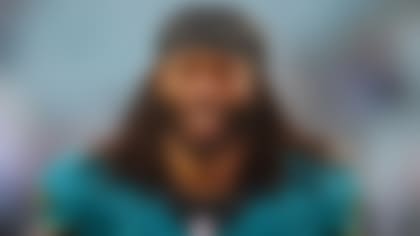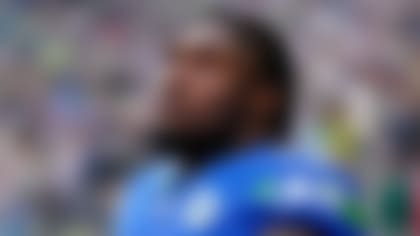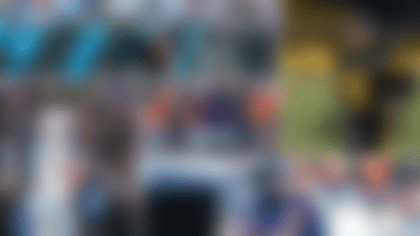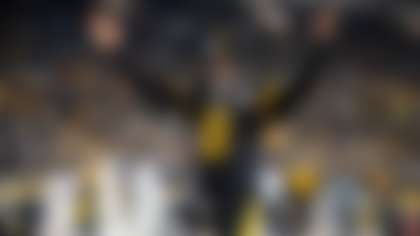Now that Super Bowl XLIV has determined a NFL champion, this is the perfect time to reflect on the good, bad and ugly moments of the 12 playoff teams' seasons. Teams are listed in the order in which they were eliminated (except for the champion New Orleans Saints, of course).
[
Green Bay Packers
The good:Aaron Rodgers topped the 4,000-yard mark for the second consecutive season and earned a Pro Bowl berth after compiling a gaudy 103.2 passer rating. The fifth-year pro tossed 30 touchdown passes against just seven interceptions while guiding the league's sixth-ranked offense. While detractors beat up Rodgers for his tendency to hold onto the ball, he has silenced critics who were upset about the youngster replacing the legendary Brett Favre in the pocket.
The bad: The much-maligned offensive line surrendered a league-worst 51 sacks. Though the unit considerably improved after the re-signing of tackle Mark Tauscher, its inability to protect Rodgers during a critical middle-of-the-season stretch cost the team a shot at the NFC North title.
The ugly: The league's second-ranked defense was shredded by the Cardinals in the playoff opener. Kurt Warner and Co. gashed Green Bay for 531 yards, and the venerable veteran QB tossed five touchdowns against a secondary that had provided suffocating coverage for most of the season. With the defense unable to stop the Cardinals' juggernaut, the Packers made an early exit despite being one of the league's hottest teams entering the postseason.
Where do they go from here? The Packers have the offensive weapons in place to be good for a very long time, but they must address their offensive line, especially at the tackle spots. Defensively, the team appeared to play better with two-time Pro Bowl pick Aaron Kampman out of the lineup, so the front office must decide what to do with the end-turned-linebacker during free agency.
[
Philadelphia Eagles
The good:DeSean Jackson emerged as one of the league's top playmakers after scoring eight touchdowns that covered 50 or more yards. The diminutive multi-purpose threat excelled as a receiver and returner, earning a Pro Bowl berth at both positions. Given Jackson's ascension to the ranks of the elite, the Eagles' offense became a feared big-play unit.
The bad: The highly anticipated Michael Vick experiment failed to produce significant results. Though the three-time Pro Bowl quarterback occasionally flashed some of his electrifying talents of old while directing the Eagles' version of the "Wildcat" offense, Vick spent most of his season standing on the sideline with a limited role.
The ugly: The Cowboys pummelled the Eagles on back-to-back weekends to win the NFC East title and eliminate Philadelphia from the playoffs. Although the Eagles finished fifth in scoring offense (26.8 points per game), the unit was shut out in the regular-season finale, then managed just 14 points on Wild-Card Weekend, looking completely overmatched both times.
Where do they go from here? The Eagles have possibly seen the last of Brian Westbrook in uniform, so most of the offseason must be spent on preparing LeSean McCoy for his role as the team's new featured running back. The defense also needs some retooling after failing to play to its lofty standard in Sean McDermott's first season as coordinator.
[
New England Patriots
The good:Tom Brady bounced back from his career-threatening knee injury to win NFL Comeback Player of the Year honors. Although Brady didn't come close to matching his exceptional production of 2007, his respectable season totals placed him among the league's top five passers.
The bad: Randy Moss' effort was called into question after a sub-par performance against the Carolina Panthers. Although the seven-time Pro Bowl selection topped the 1,000-yard mark for the 10th time in 12 seasons, he finished with eight consecutive games of fewer than 100 receiving yards. Moss' lackluster effort in several games led to discussions about his skills rapidly declining.
The ugly:Bill Belichick's controversial fourth-down gamble against the Colts backfired when the Patriots failed to convert from deep in their own territory. The contentious decision fueled endless speculation about the coach's lack of confidence in his defense in critical situations.
Where do they go from here? The Patriots enter the offseason with major questions on both sides of the ball. Wes Welker's serious knee injury and Moss' subtle decline might force the team to move away from its potent spread offensive attack. The defense's inconsistency has prompted Belichick to take a more active role in the unit in 2010. With numerous changes on the horizon, the Patriots could see their division rivals pass them by next season.
[
Cincinnati Bengals
The good: Cedric Benson finished as the second-leading rusher in yards per game (96.2) and broke the team's single-season record with six 100-yard rushing games. The fifth-year pro surpassed the 1,000-yard mark for the first time in his career and removed the "bust" label that had been attached to him.
The bad:Carson Palmer recorded only one 300-yard game, resulting by far in his lowest season total for passing yards (3,094) when starting all 16 games. While some of Palmer's waning production can be tied to Benson's emergence in the running game, the fact that the former Pro Bowl quarterback had six games with fewer than 200 passing yards suggests there was a serious issue with the Bengals' aerial attack.
The ugly: The team dropped three of its last four games but backed into the AFC North title. The loss of momentum led to an early playoff exit and diminished the significance of the Bengals' numerous accomplishments throughout the season.
Where do they go from here? The Bengals remade themselves into a tough, physical squad anchored by a hard-hitting defense and a smashmouth running game. The makeover lifted Cincinnati to a division crown, but a vastly improved aerial attack is needed to compete with the elite teams in the AFC.
[
Arizona Cardinals
The good: The Cardinals won their second consecutive NFC West title behind Kurt Warner's solid play. Though the veteran quarterback didn't surpass the 4,000-yard mark, his ability to pick apart defenses with pinpoint throws made Arizona seemingly impossible to slow down.
The bad: Matt Leinart posted a putrid 64.6 passer rating in eight appearances, which included one start (against the Tennessee Titans). With three interceptions in 77 pass attempts, the future franchise quarterback's play didn't inspire confidence from his teammates or Cardinals supporters. Given Warner's retirement, Leinart has a full offseason to gain some trust.
The ugly: Chris "Beanie" Wells and Tim Hightower combined for just two 100-yard rushing games. This led to the Cardinals ranking 29th in rush offense despite coach Ken Whisenhunt's continued efforts to make the offense more balanced. Without a consistent running game to alleviate the pressure on their explosive aerial attack, Arizona remains an up-and-down unit unable to consistently win big games.
Where do they go from here? Leinart's readiness to assume the starting quarterback job will dominate most of the offseason conversation, but the team must continue to address its rushing attack to alleviate pressure on the passing game. Additionally, the Cardinals must prepare to deal with the exorbitant contract demands made by several stars (Anquan Boldin, Karlos Dansby and Darnell Dockett).
[
Dallas Cowboys
The good:Miles Austin went from role player to Pro Bowl receiver in his first season as a starter. The fourth-year pro filled Terrell Owens' role as the team's big-play threat and finished the season with 1,320 receiving yards. Austin recorded five 100-yard games -- including a 250-yard explosion against the Kansas City Chiefs in his first start -- and finished fourth in the league with 11 receiving touchdowns.
The bad: The secondary tallied just 11 interceptions. Though Mike Jenkins picked off five passes on his way to earning a Pro Bowl berth, the unit's inability to create turnovers wasted the efforts of a pass rush that ranked among the top of the league in sacks.
The ugly: Roy Williams failed to emerge as the No. 1 receiver, despite being anointed as such before the season. The former Pro Bowl pick finished as the team's third-leading receiver with just 38 catches and produced only one 100-yard game.
Where do they go from here? The Cowboys finally shook their postseason malaise to advance to the divisional round, but coach Wade Phillips will be under the gun to have his team make a serious Super Bowl push. With a solid roster in place, Dallas only needs to add a few pieces to climb atop the NFC.
[
Baltimore Ravens
The good:Ray Rice enjoyed a breakout season as the team's multi-purpose weapon. The Pro Bowl selection amassed more than 2,000 total yards from scrimmage and is regarded as one of the league's most dangerous runners. Given his ability to influence the game in multiple areas, Rice's emergence gave the Ravens a solid piece to build around offensively.
The bad: The Ravens fielded the league's third-best defense under new coordinator Greg Mattison, but the secondary's penchant for blowing assignments resulted in opponents tallying eight pass plays for more than 40 yards during the season. That contributed to the team stumbling to a 5-5 start.
The ugly: The Ravens' scattershot aerial attack had a great start, as Joe Flacco recorded three 300-yard passing games in the first six weeks. However, the second-year QB failed to surpass that total the rest of the season, and inconsistency through the air cost the team dearly in big games.
Where do they go from here? The Ravens have reached the playoffs in consecutive years under coach John Harbaugh, but their passing game needs more weapons for the team to emerge as a serious contender. With an aging Derrick Mason and Todd Heap as top targets, expect Baltimore to address its receiving corps during the offseason.
[
San Diego Chargers
The good:Philip Rivers spearheaded a high-octane offense that terrorized opponents with the long ball. The Pro Bowl quarterback averaged 8.8 yards per attempt, and his 64 completions of more than 20 yards led the league. With wide receivers Vincent Jackson and Malcom Floyd and tight end Antonio Gates enjoying sizable advantages over most defenders, Rivers' long-ball tactics propelled the Chargers to a 13-3 regular-season record.
The bad: San Diego inexplicably dropped a home playoff game after being roundly touted as the AFC favorite with an 11-game winning streak heading into the postseason. Plagued by mental miscues, turnovers and penalties, the Chargers allowed an overmatched Jets team to pull off a stunning upset.
The ugly: The Chargers' rush offense ranked 31st in the league behind an aging LaDainian Tomlinson. The nine-year veteran failed to surpass the 1,000-yard mark for the first time in his career and averaged a paltry 3.3 yards per carry.
Where do they go from here? The Chargers' window for winning a championship is closing fast, as several members of the team's core are nearing the end of their respective contracts. Given general manager A.J. Smith's reputation for being a no-nonsense negotiator, San Diego undoubtedly will field a lineup featuring several new starters in 2010.
[
Minnesota Vikings
The good: The Brett Favre experiment was an overwhelming success, as the 19-year veteran enjoyed one of the best seasons of his illustrious career directing the Vikings' offense. Favre's presence also sparked Sidney Rice's development into a Pro Bowl pass catcher.
Top offseason storylines
Looking ahead to a busy offseason in the NFL, it appears Brett Favre's on-again, off-again retirement will continue to dominate headlines, Steve Wyche writes. **More ...**
The bad:Adrian Peterson took a backseat to Favre in the Vikings' redesigned offense. Though the third-year pro finished as the league's fifth-leading rusher, Peterson went eight consecutive weeks without a 100-yard game down the stretch and showed a penchant for fumbling in key moments.
The ugly: The Vikings failed to advance to the Super Bowl despite outplaying the Saints for most of the NFC Championship Game. Plagued by turnovers and numerous mental miscues, the Vikings squandered an early lead to lose a hard-fought game in overtime.
Where do they go from here? Coach Brad Childress will spend most of the offseason attempting to convince Favre to return for one final run at the title, but the grizzled veteran might not have the energy to endure another 16-game campaign. How well Childress recruits Favre will determine if the Vikings enter 2010 as front-runners in the NFC.
[
New York Jets
The good:Darrelle Revis emerged as the premier cover man in the league, as he shut down a Murderer's Row of receivers during the season (Texans' Andre Johnson, Patriots' Randy Moss, Bills' Terrell Owens, Panthers' Steve Smith and Bengals' Chad Ochocinco). With Revis capable of shutting down one side of the field, Jets coach Rex Ryan was able to incorporate some exotic blitzes to anchor the league's top-ranked defense.
The bad: The Jets suffered through quarterback Mark Sanchez's rookie struggles during the middle of the season. He tossed 20 interceptions, including 10 during a five-game stretch between Weeks 10 through 15. While Sanchez showed flashes of brilliance during the playoffs, his penchant for turnovers forced the team to play close to the vest down the stretch.
The ugly: Braylon Edwards was acquired to be the team's No. 1 receiver, but his New York tenure has been plagued by inconsistency. The fifth-year pro averaged a robust 15.5 yards per reception, but he produced just four touchdowns despite being anointed as the team's "go-to-guy."
[
Indianapolis Colts
The good:Peyton Manning won a record fourth league MVP award while guiding the Colts to a 14-0 start and their 10th playoff appearance in the last 11 seasons. Manning finished second in the NFL in passing yards (4,500) and touchdowns (33) while compiling a gaudy 107.2 rating.
The bad: Team president Bill Polian and coach Jim Caldwell made the controversial decision to rest several of their starters down the stretch despite having a legitimate shot at an unbeaten season. The surprising choice resulted in the Colts losing the last two games of the regular season and sparked a huge debate over the value of a perfect record.
The ugly: The Colts failed to deliver a Super Bowl title despite taking precautions to ensure the health of their key players heading into the playoffs. Ironically, the ankle injury that defensive end Dwight Freeney suffered in the AFC Championship Game played a major role in the defense's inability to stop Saints quarterback Drew Brees during the second half of the Super Bowl.
Where do they go from here? The Colts will spend the offseason enduring the host of "what ifs" after failing to win a Super Bowl title following a 14-0 start. However, with Manning and a host of young playmakers set to return for another run at the championship, Indianapolis is well positioned to remain among the ranks of the elite for years to come.
[
New Orleans Saints
The good: The Saints' defense finished second in the league in takeaways, and their opportunistic ways resulted in seven defensive scores. Although the unit struggled during the final stretch of the regular season, it regained its swagger during the playoffs and carried New Orleans to the Super Bowl title.
The bad: The Saints lost their final three regular-season games, leading to questions about their ability to recapture the momentum from their 13-game winning streak and their worthiness as title contenders.
The ugly: The debauchery taking place on Bourbon Street after the Saints bring home their first Super Bowl title. The celebration has been aptly dubbed "Lombardi Gras" because it came one week before Mardi Gras in New Orleans.
Where do they go from here? The Saints captured the country's attention on their way to winning their first championship. Yet, coach Sean Payton and general manager Mickey Loomis must make a series of prudent roster decisions to ensure New Orleans' standing as a title contender next season.




